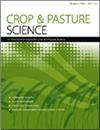植物种类、氮状态和内生菌是草地土壤微生物群落的驱动因子
IF 1.9
4区 农林科学
Q2 AGRICULTURE, MULTIDISCIPLINARY
引用次数: 0
摘要
人们担心,“新”植物种质/性状的引入可能超过我们测量和评估它们对土壤微生物群落和功能的影响的能力。目的研究2年内植物种类/功能性状、氮肥和内生菌侵染对草地土壤微生物群落的影响。方法在同一土壤中进行2个单作样地的田间试验。实验1用两种多年生黑麦草(Lolium perenne)的果聚糖含量不同,以及豆科植物白三叶草(Trifolium repens)和鸟脚三叶草(Lotus peddunculatus)的单宁含量不同,比较了禾草和豆科植物。禾草处理施氮量分别为高施和低施。实验2比较了Epichloë菌株在黑麦草、高羊茅(Schedonorus phoenix)和草甸羊茅(Schedonorus pratensis)中的存在与缺失。采用高通量测序方法对土壤岩心中分离的DNA进行分析。主要结果禾本科土壤中木质素降解真菌丰度较高,豆科土壤中果胶降解真菌丰度较高。黑麦草氮肥和果聚糖水平对土壤真菌群落的影响较小。相比之下,施氮或固氮对细菌群落有很强的影响,在高氮禾本科土壤和豆科土壤中,硝化和反硝化菌的丰度高于低氮禾本科土壤。Epichloë通过降低某些真菌植物病原体的丰度,增加菌根真菌和减少固氮细菌来影响土壤微生物群。结论禾本科和豆科植物细胞壁化学成分的差异以及禾本科中Epichloë的存在是土壤微生物群落变化的主要驱动因素。在牧场管理中,应考虑单种或多种栽培、氮肥和草料中Epichloë的存在等耕作方式对土壤微生物群落的影响。本文章由计算机程序翻译,如有差异,请以英文原文为准。
Plant species, nitrogen status and endophytes are drivers of soil microbial communities in grasslands
Context There is concern that the introduction of ‘novel’ plant germplasm/traits could outpace our capacity to measure and so assess their impacts on soil microbial communities and function.Aim This study aimed to investigate the effects of plant species/functional traits, nitrogen (N) fertilisation and endophyte infection on grassland soil microbial communities within a short time span of 2years.Methods Two field experiments with monoculture plots were conducted in a common soil. Experiment 1 compared grasses and legumes, using two cultivars of perennial ryegrass (Lolium perenne) that varied in fructan content, along with the legumes white clover (Trifolium repens) and bird’s-foot trefoil (Lotus pedunculatus) that varied in tannin content. Grass treatments received high and low N application levels. Experiment 2 compared the presence/absence of Epichloë strains in ryegrass, tall fescue (Schedonorus phoenix) and meadow fescue (Schedonorus pratensis). Soil microbial communities were analysed by using high-throughput sequencing of DNA isolated from bulk soil cores.Key results Higher abundance of ligninolytic fungi was found in grass soils and pectinolytic fungi in legume soils. Levels of N fertilisation and fructan in ryegrass had only minor effects on soil fungal communities. By contrast, N fertilisation or fixation had a strong effect on bacterial communities, with higher abundance of nitrifiers and denitrifiers in high-N grass soils and in legume soils than in low-N grass soils. Epichloë affected soil microbiota by reducing the abundance of certain fungal phytopathogens, increasing mycorrhizal fungi and reducing N-fixing bacteria.Conclusions Chemical composition of plant cell walls, which differs between grasses and legumes, and presence of Epichloë in grasses were the main drivers of shifts in soil microbial communities.Implications Impacts of farming practices such as mono- or poly-culture, N fertilisation and presence of Epichloë in grasses on soil microbial communities should be considered in pasture management.
求助全文
通过发布文献求助,成功后即可免费获取论文全文。
去求助
来源期刊

Crop & Pasture Science
AGRICULTURE, MULTIDISCIPLINARY-
CiteScore
4.20
自引率
15.80%
发文量
111
审稿时长
3 months
期刊介绍:
Crop and Pasture Science (formerly known as Australian Journal of Agricultural Research) is an international journal publishing outcomes of strategic research in crop and pasture sciences and the sustainability of farming systems. The primary focus is broad-scale cereals, grain legumes, oilseeds and pastures. Articles are encouraged that advance understanding in plant-based agricultural systems through the use of well-defined and original aims designed to test a hypothesis, innovative and rigorous experimental design, and strong interpretation. The journal embraces experimental approaches from molecular level to whole systems, and the research must present novel findings and progress the science of agriculture.
Crop and Pasture Science is read by agricultural scientists and plant biologists, industry, administrators, policy-makers, and others with an interest in the challenges and opportunities facing world agricultural production.
Crop and Pasture Science is published with the endorsement of the Commonwealth Scientific and Industrial Research Organisation (CSIRO) and the Australian Academy of Science.
 求助内容:
求助内容: 应助结果提醒方式:
应助结果提醒方式:


